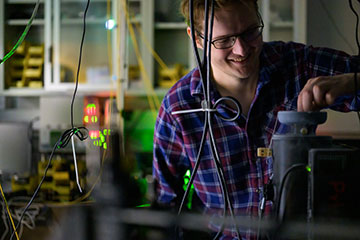
Trevor Ollis fills a camera with liquid nitrogen to cool it to −120°Cto examine monolayer materials. [Image: University of Rochester Photo / J. Adam Fenster]
The emerging field of twistronics explores physics and phenomena that arise from modifying the relative twist angle between successive layers in 2D materials. Atomically thin materials can be vertically and horizontally stacked to create nanostructures, often producing unexpected results.
Now, researchers from the University of Rochester, USA, have discovered that twisting two layers of molybdenum diselenide at large angles alters the material’s optical properties in an intriguing way (Nano Lett., doi: 10.1021/acs.nanolett.5c00456). The bilayer produces brightened dark excitons that retain information when activated by light and could act as qubits in future quantum devices.
Exploring larger angles
Up to this point, most studies in twistronics have focused on small-angle twisted bilayers that produce the classic Moiré pattern. Such nanostructures have been shown to form periodic arrays of programmable excitonic quantum emitters with applications in quantum computation. Larger angles have been less explored, since they do not exhibit periodicity and lead to the uncoupling of electronic communication between the two layers.
The lab of Nickolas Vamivakas sought to explore what large twist angles had to offer, despite their lack of a Moiré superlattice. The researchers created a twisted n-doped molybdenum diselenide bilayer with a stacking angle of 41.27° and employed standard microphotoluminescence to characterize its optical properties. They observed the emergence of a brightened dark intralayer exciton that diffuses more efficiently than bright excitons or trions.
They observed the emergence of a brightened dark intralayer exciton that diffuses more efficiently than bright excitons or trions.
“A single layer of the material contains both bright and dark excitons. By adding a second twisted layer, the bright and dark excitons mix,” said Vamivakas. “Brightening the dark exciton means it can emit light, but since the brightened dark exciton has some dark character, it is better protected and less susceptible to noise than the fully bright exciton.”
Toward quantum memory
Vamivakas and his colleagues foresee new possibilities for these brightened dark excitons as a component of quantum networks and quantum polaritonic devices. The quasi-particles also possess interesting valley behavior that can be leveraged as a qubit, according to Vamivakas, and their anticipated longer lifetimes are appealing for exciton–polariton devices.
“Down the line, we hope these artificial atoms can be used like memory or nodes in a quantum network, or put into optical cavities to create quantum materials,” he said. “These could be the backbone for devices like the next generation of lasers or even tools to simulate quantum physics.”
